Medicinal properties and contraindications of gooseberry berries and leaves
Gooseberry is widely used not only in cooking, but also in folk medicine for the treatment and prevention of various painful conditions. Its berries and leaves contain vitamins, minerals, organic acids, antioxidants, tannins and other valuable elements that are important for health and wellness.
But even the most useful product has not only pluses, but also minuses. Therefore, first you need to figure out what the berries are for, how to use them as a medicine, what are the medicinal properties of gooseberry leaves and what are the contraindications.
The content of the article
Composition of gooseberry berries and leaves
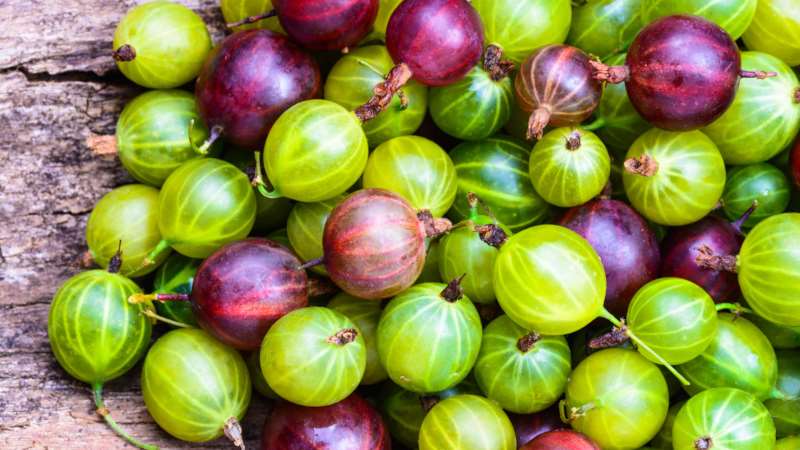
The chemical composition of gooseberries depends on the variety, conditions cultivation and storage. The fruits contain:
- organic acids;
- alimentary fiber;
- water;
- ash;
- vitamin A;
- beta carotene;
- B vitamins: B1, B2, B3, B4, B5, B6, B9;
- vitamins C, E, H, K, PP;
- macroelements: potassium, calcium, silicon, magnesium, sodium, sulfur, phosphorus, chlorine;
- trace elements: aluminum, boron, vanadium, iron, iodine, cobalt, lithium, manganese, copper, molybdenum, nickel, selenium, strontium, fluorine, chromium, zinc, zirconium;
- digestible carbohydrates: glucose, sucrose, fructose;
- saturated fatty acids;
- omega-3 fatty acids.
The chemical composition of the leaves is no less varied. It contains such valuable substances for the human body as:
- vitamins A, C, E;
- B vitamins: thiamine, riboflavin, niacin, choline, pantothenic and folic acids, pyridoxine;
- organic acids: malic, citric, oxalic;
- tannins;
- flavonoids;
- pectin;
- minerals.
Useful and medicinal properties
The rich composition of gooseberries determines its useful and even medicinal properties:
- Retinol (vitamin A) has a beneficial effect on the skin: accelerates the processes of tissue regeneration, lightens age spots, tones, prevents the formation of mimic wrinkles. Supports the proper functioning of the organs of vision, sweat and sebaceous glands, participates in the conversion of cholesterol, regulates carbohydrate, protein and lipid metabolism.
- Thiamin (vitamin B1) essential for the health of the digestive and nervous systems, improves the delivery of oxygen to the heart muscle, activates blood flow, promotes the timely renewal of the blood composition.
- Riboflavin (vitamin B2) takes part in the formation of red blood cells (erythrocytes), has a beneficial effect on the digestive system, removes toxic substances from the body.
- Pyridoxine (vitamin B6) lowers the concentration of bad cholesterol, which serves as the prevention of heart and vascular diseases. Ensures proper functioning of the central and peripheral nervous system, strengthens hair and nails, is important for bone formation and mineralization of teeth.
- Ascorbic acid (vitamin C) - a powerful antioxidant that enhances the protective functions of the immune system, increases the body's resistance to infectious diseases. Promotes normal absorption of calcium and iron, increases the strength and elasticity of the vascular walls.
- Alpha Tocopherol (Vitamin E) stimulates collagen production, slows down the aging process, takes care of the skin.It improves blood circulation and the functioning of the nervous system, prevents the development of anemia, and takes part in the metabolism in the liver.
- Nicotinamide (vitamin PP) supports redox processes at the proper level, activates fat metabolism, regulates carbohydrate and water-salt metabolism, promotes the production of adrenal hormones, and improves immunity.
Gooseberry also valued for its fiber content. They are not absorbed and, like brushes, cleanse the intestines from accumulated toxins, normalize stools, and stimulate intestinal peristalsis.
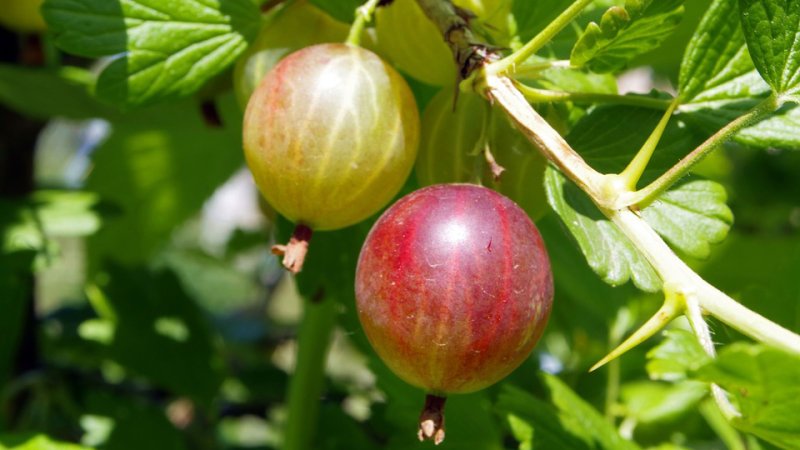
Gooseberry has a pronounced choleretic and diuretic effect, removes excess fluid from the body, helps to get rid of edema. Other medicinal properties are manifested in the ability to inhibit inflammation, destroy harmful microorganisms or suppress their growth, and relieve joint and muscle pain.
Council. Gooseberry is recommended for people engaged in hard physical and mental work, as it increases endurance and performance, helps to quickly restore strength, and put in order the nervous system.
Gooseberry leaves are used as medicinal raw materials. Due to their equally rich composition, they have a beneficial effect on the body, prevent painful conditions from the heart, blood vessels, nervous, urinary, respiratory systems, gastrointestinal tract, skin, and organs of vision.
For women
Gooseberry should be present in the diet of women, regardless of age. It is recommended for vitamin deficiency, deficiency of trace elements and minerals, for the correction of mineral metabolism.
Berries are useful when planning pregnancy, during gestation, after childbirth, during and after breastfeeding. The fact is that the fruits contain folic acid (vitamin B9), which is important for the health of the mother and child. Deficiency of this substance can cause anemia, impairment of the normal development of the nervous system in the fetus, premature birth or spontaneous miscarriage.
Vitamin B2, which is also found in gooseberries, takes part in the physiological formation of fetal tissues and organs. The development of placental tissue in accordance with all the needs of the unborn child is regulated by vitamin E.
Gooseberry is especially useful for women over the age of 30, as it slows down the onset of menopause, relieves menopause symptoms, and supports the functioning of the reproductive system. By consuming berries regularly, there is no need to fear for the condition of the skin and hair.
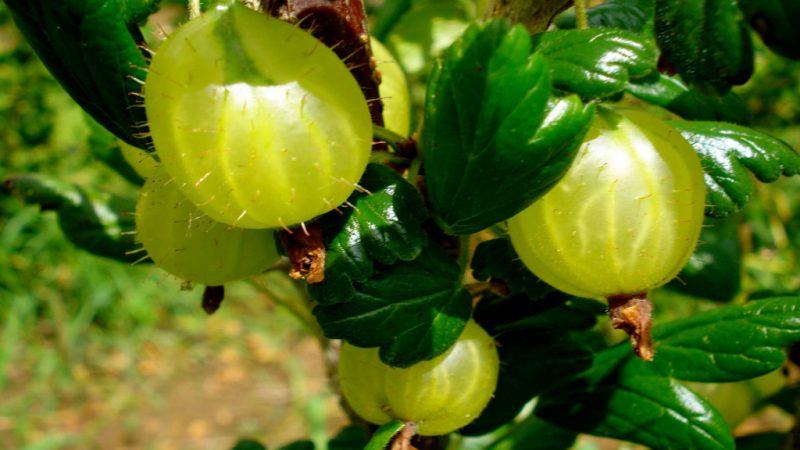
The undeniable benefits of gooseberries in maintaining or losing weight:
- has a low calorie content (45 kcal per 100 g), practically does not contain fats (0.2 g), but it is rich in proteins (0.7 g) and carbohydrates (9.1 g);
- provides a quick feeling of fullness, energizes for a long time, without converting carbohydrates into new fat deposits;
- reduces blood sugar, which is especially important during weight loss;
- pectin cleanses the body of toxins and toxins, promotes the growth of beneficial bacteria in the intestines;
- vitamins and minerals normalize metabolism, improve digestion.
For men
Gooseberry has a beneficial effect on the male body: it strengthens the immune system, prolongs youth, keeps the skin in good condition, removes accumulated toxins.
Berries are of particular importance for the genitourinary system. Regular use of gooseberries can prevent or alleviate inflammatory diseases such as cystitis, pyelonephritis, prostatitis.
Vitamins A, B, C improve blood circulation in the pelvic organs, which has a positive effect on sex drive and sexual health. Plus, high levels of zinc increase testosterone production. It is an important male sex hormone responsible for sex drive, erection, and development of muscles and genitals in adolescents and boys.
Gooseberry in folk medicine
Gooseberries are widely used in folk medicine. Having a rich vitamin and mineral complex, the leaves and fruits of the plant help prevent various diseases, and in the presence of pathologies, accelerate recovery and prevent possible complications.
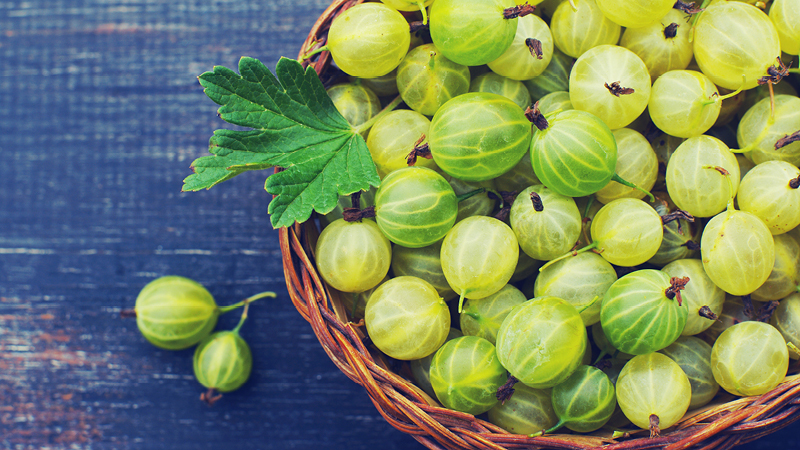
What gooseberry helps with:
- Anemia. Berries are used when there is insufficient concentration of iron in the body and to prevent a decrease in hemoglobin levels. They serve as an additional source of iron, as well as vitamin C, which promotes better absorption of iron. Helps to alleviate the severity of nervous system symptoms such as lethargy, fatigue, decreased performance. It also prevents negative manifestations from the digestive system in the form of nausea, vomiting, constipation.
- Urolithiasis disease. Berries, decoction and infusion from the leaves help to remove stones, have diuretic and choleretic properties. Organic acids prevent the deposition of salt crystals, and vitamins in combination with dietary fiber normalize metabolism, since it is metabolic disorders that contribute to the development of the disease.
- Diabetes... Gooseberry has a low glycemic index (25 units), respectively, does not increase glucose levels, does not overload the pancreas, removes excess bad cholesterol from the body, and normalizes metabolism.
- Diseases of the cardiovascular system (myocardial infarction, ischemia, atherosclerosis, angina pectoris). The berries and leaves of the plant directly affect the root cause of pathologies: they normalize lipid metabolism, reduce blood cholesterol levels, stimulate blood flow, increase the strength and elasticity of vascular walls and capillaries. Berries saturate the body with potassium and magnesium, which relax the heart muscles, regulate blood pressure, and improve the process of neuromuscular transmission.
- Diseases of the musculoskeletal system. Berries relieve the condition of people suffering from osteochondrosis, gout, rheumatism, arthritis and arthrosis. Gooseberry stops the inflammatory process, reduces the severity of pain, strengthens connective tissue structures, normalizes the metabolism in the joints. Organic acids dissolve uric acid crystals, preventing them from accumulating.
- Influenza, ARVI, ARI and other infectious diseases of the respiratory system. Gooseberry contains large doses of vitamin C, which strengthens the immune system, protects against infections, stops inflammation, and inhibits the release of histamine (a mediator of allergic reactions). For the treatment and prevention of colds, the antioxidant properties of gooseberry and its leaves are used.
- Skin diseases. Since skin diseases in most cases are associated with metabolic disorders and pathologies of the gastrointestinal tract, gooseberry has a positive effect on metabolism, removes toxins from the intestines, and improves the intestinal microflora. Plays an important role in the fight against constipation. Vitamins A and E reduce the severity of allergic manifestations, accelerate skin healing.
Contraindications
The main contraindication for the use of gooseberry and drugs based on its leaves is individual intolerance to one or more of the components of the composition.
Nutritionists recommend limiting or completely eliminating berries from the diet of people suffering from diseases of the digestive system of an erosive and ulcerative nature, especially in the acute stage. The fact is that the organic acids contained in the composition have an adverse effect on the affected mucous membrane, and the hard skin is poorly digested. Bloating may occur, and painful sensations may worsen.
When to collect and harvest gooseberry raw materials
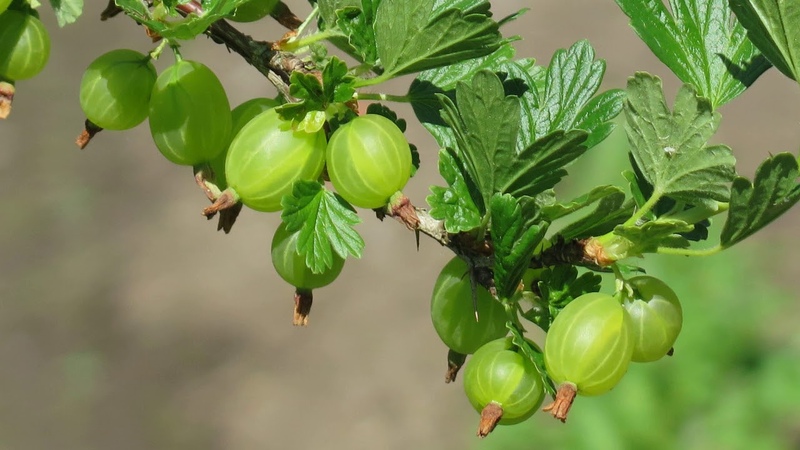
The biological ripening period of berries is June - August (depending on the variety, weather and climatic conditions). If you plan to harvest gooseberries for the winter or process them, they must be harvested 10-15 days before they are fully ripe.The berries are already normal in size, with well-visible veins, but still retain their firmness. Such a crop can be stored for 30 days if the proper temperature regime is observed from 0 ° С to + 2 ... + 3 ° С. In the freezer gooseberries are stored for about 12 months.
Council. Pay attention to appearance. Unsuitable for consumption and storage are spoiled, overripe berries with traces of damage by insects.
The berries are harvested in dry weather until mid-afternoon, when the morning dew is completely dry. In order not to injure your hands, use thick garden gloves. For long-term storage, choose only fruits that are dense to the touch. Collect the gooseberries in small containers (average volume - 2-2.5 liters) so as not to transfer the berries. At room temperature, the crop is stored for no more than 2-3 days.
Gooseberry leaves are used medicinally, so it's important to know when and how to pick them.
When to collect leaves
Leaves, like berries, are harvested in dry, sunny weather. Spoiled and dirty raw materials are not used for harvesting, since they are not pre-washed under running water. The fact is that on the surface of the leaves there are bacteria that take part in fermentation. It is best to harvest leaves not in early spring, but in autumn, when the shrub has finished fruiting. Then the beneficial properties and smell of the leaves are amplified at times.
How to dry and ferment leaves
The collected leaves must be dried, as excess moisture will not allow high-quality fermentation and drying. To do this, they are laid out in a thin layer on a cotton towel and periodically shaken. On average, the drying process takes about 12 hours, depending on the condition of the raw materials, temperature and climatic conditions. The best air temperature is + 20 ... + 25 ° С, humidity - 65-70%.
If, when the leaf is crumpled, a crunch is not heard in the place of the central vein, proceed to the next stage - fermentation. Leaves can be prepared in any way:
- twist in a meat grinder;
- knead with squeezing movements in a wide container;
- roll 8-10 leaves between your palms until juice is formed.
The crushed leaves are tightly placed in a dry glass or porcelain container, covered with an airtight lid so that there is no access to air, and left in a warm place. Fermentation time depends on the temperature: the higher it is, the faster the process takes place. The optimum temperature is + 22 ... + 26 ° С.
For reference. At a temperature of + 15 ° C and below, the fermentation process stops, at + 30 ° C and above, the quality of raw materials deteriorates.
On average, fermentation lasts 1-2 days. On the third day, the leaves may become moldy or fermented, which should not be allowed. Further, granules of arbitrary shape and size are formed from plastic green mass or left as they are.
Next, they move on to the last stage of preparing raw materials - drying the leaves. At home, they are usually dried naturally in the open air. If climatic conditions do not allow, use an oven, stove or any room (attic, place under a canopy) where good air circulation is provided. You can dry the leaves on dryers for fruits and vegetables, maintaining the optimum temperature at + 37 ... + 37.5 ° C.
Natural drying takes place in several stages:
- Leaves or granules are spread in a thin layer on a canvas or paper in the open air with a through wind.
- It is better to dry the leaves in a draft, in such conditions moisture evaporation occurs faster. You can not leave raw materials in the sun, because under the influence of its rays, the active components of the composition are rapidly destroyed, the color and aroma change.
- To prevent dust from getting on the leaves, you can cover them with gauze or a thin cloth.
- When the leaves are ground into powder, they do not stick together in a lump, then drying is over. Well dried raw materials retain their natural color. Blackened leaves indicate that the raw material has not been properly dried, its beneficial properties have been lost.
After drying, the leaves are placed in plastic containers, glass containers, cloth bags and stored in a dark, dry place.
Medicinal recipes
Both berries and leaves are used as a medicine. The fruit is usually eaten fresh or juiced. Tea is brewed from the leaves, infusions and decoctions are prepared, which, depending on the indications, are taken orally or used externally in the form of a compress and rubbing.
Leaf tea
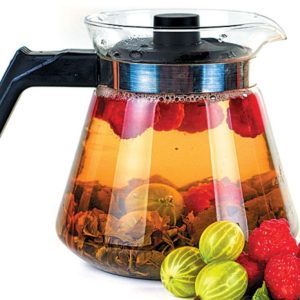
Gooseberry leaf tea is used as both a drink and a medicine. It contains many substances useful for the human body, which minimizes the risk of diseases of the heart and blood vessels, nervous, urinary and digestive systems. In winter, this good vitamin remedy protects against flu and colds, increases the body's resistance to infections. The leaf tea, which has decongestant properties, is useful for people suffering from hypertension, excessive swelling, and obesity.
How to prepare tea from leaves:
- 2 tbsp. l. 200-250 ml of boiling water is poured over dried leaves and insisted under a lid for 5-10 minutes.
- Add honey, lemon, ginger, mint to the finished drink. These substances not only change the taste, but also enhance the medicinal properties of gooseberries, complementing them with new medicinal effects.
Infusion of leaves
The infusion is prepared from 2 tbsp. l. raw materials and 500 ml of water. The leaves are poured into an airtight container, poured with boiling water, insisted under a closed lid (preferably in a thermos) for 60 minutes, then filtered.
The infusion is characterized by a wide spectrum of action. It is recommended to be used for such diseases and conditions as:
- tuberculosis;
- avitaminosis;
- obesity;
- prevention of anemia;
- malnutrition (to compensate for the deficiency of minerals and vitamins);
- the rehabilitation period after injuries, antibiotics, diseases.
Leaf decoction
For the preparation of the broth, both fresh and dried gooseberry leaves are used:
- 1 tbsp. l. plant materials are crushed and poured with 500 ml of cold water.
- In a water bath, bring to a boil and cook over medium heat for about 15 minutes.
- Remove from heat, let it brew under the lid for 1-2 hours, filter.
The broth is recommended to be used as a compress for people suffering from arthritis, arthrosis, osteochondrosis. Inside take for the treatment and prevention of acute respiratory viral infections, acute respiratory infections, influenza, diseases of the teeth and oral cavity.
A decoction of gooseberry leaves is a popular cosmetic product. They treat the scalp with active hair loss, seborrhea, baldness. The ice, made from the decoction, tones up well, refreshes the skin, reduces pigmentation, and prevents the formation of wrinkles.
How berries are used
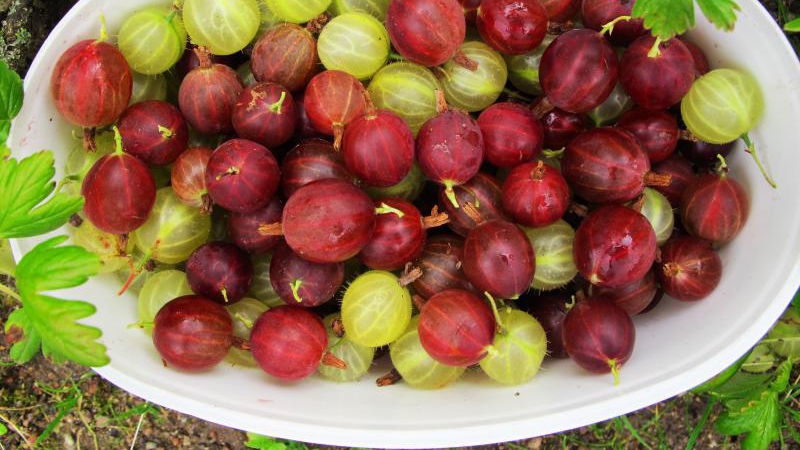
Berries are consumed fresh, frozen, processed into juice, used to prepare compote, jelly, jam, marmalade. But you should know that, depending on the cooking technology, gooseberries are not always equally useful. For greater benefit, nutritionists recommend eating fresh berries without prior heat treatment. Sugar gooseberries are contraindicated for people suffering from obesity and diabetes.
It is interesting:
Why did gooseberry rust appear and what to do to get rid of it.
Instructions for planting gooseberries in the fall and further care for them.
Conclusion
The beneficial properties of gooseberries are undeniable. Its fruits and leaves are in demand in the treatment and prevention of cardiovascular diseases, pathologies of the nervous system, gastrointestinal tract. Berries are useful for those who seek to lose weight, cleanse the intestines of toxins and toxins, improve the condition of the skin and nails.
Tea, broth and infusion of gooseberry leaves are an ideal drink in every way. It has a great aroma and taste, invigorates, replenishes the deficiency of vitamins and minerals, and has a beneficial effect on the human body as a whole.